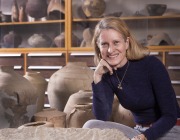Scientific Biography
Katia Cytryn-Silverman
My belief
As an archaeologist of the Islamic period, I believe that sites and artifacts can only be fully understood if studied in their historical and social context. I also believe that historians can best understand events, rulers, societies, or even whole historical periods, by knowing the material culture of the time – what was built, what was culturally admired, and what was routinely used. Within my field, this multi-dimensional study can be achieved if Islamic archaeologists are proficient in Islamic history, are well trained to fully explore the written sources, and learn to cooperate with practitioners of various academic disciplines. I hope to imbue this belief both in my students and my colleagues.
Research and Field Work
A. Director, Tiberias Excavations: During archaeological works in Tiberias between 1952 and 1958, a monumental pillared-building – thought to be a covered market – was exposed together with a bathhouse and the city's main north-south street (the cardo). During the first decade fo the 2000, during a visit to the site I noted a profound affinity between the "covered market" and the eighth-century Umayyad mosque of Damascus (see List of Publications, #23). In 2009 I was granted a license to further excavate the site and since Spring of that year (#24, #26) I have been director of The Renewed Tiberias Excavation Project (http://archaeology.huji.ac.il/Tiberias/ and https://www.facebook.com/tiberiasexcavations). The ongoing excavation not only focuses on the since-proven Friday Mosque of Early Islamic Tiberias, but also on its surroundings, including a church of the Byzantine period, a domestic complex of the early Islamic period, as well as a medieval complex related to the sugar industry of the twelfth-thirteenth century. The project also researches the Islamization of the urban fabric of the classical city and on the transformation of the site into a possible industrial area in the medieval period. The project has been generously funded by Van Berchem Foundation in Genève (2008-2015), by the Y. Hirschfeld’s Memorial Fund of Yad HaNadiv, by the Amiran Fund, 2009 –2015), by ISF Centre of Excellence no. 1679/09 project (The Formation of Islamic Society in Palestine, 600-1500, 2009 to date), and the Fritz Thyssen Foundation, Cologne (2011-2012).
B. Co-Director, Khirbat al-Minya Excavations: The Khirbat al-Minya project began in 2005 and was co-directed by Prof. Myriam Rosen-Ayalon, architect and conservator Giora Solar, and myself. The site is located on the north-western shore of the Sea of Galilee. It consists of a quadrangular enclosure dated to the eighth century CE, and is identified as an Umayyad palace. The site was later re-used as a sugar manufacturing plant. During the 2005 and 2006 excavation seasons, different aspects of this later usage as well as new findings, dating back to the building's first phase, were exposed. The excavation data and findings are currently being processed under my supervision and the final report will soon be published. Renewed excavations are planned for the end of 2019, in collaboration with the German Protestant Institute of Archaeology (DEI) of Jerusalem.
C. Road Archaeology in Palestine during the Islamic period: The research on "Road Archaeology" which followed and broadened my PhD research on the road stations (khāns) in Palestine during the Mamlūk period (1260-1516), as well as my work on road archaeology conducted under the auspices of the Golda Meir Postdoctoral Fellowship, is still in process. Plans for a monograph to include aspects of road archaeology from the Umayyad to the early Ottoman periods will hopefully soon materialize.
D. The Islamic Period in Northern Sinai: The Northern Sinai Project, under the directorship of Prof. E. Oren of Ben-Gurion University aims at publishing the results of field surveys undertaken during the 1970s. The pottery finds of the Islamic period, among the material returned to Egypt in 1982, was the topic of my MA thesis, later published as an article. It is still the aim of the project to publish the results in a series, perhaps even combined with the study on road-archaeology and the research of the Mamlūk Royal Mail (barīd).
E. The Pottery of the Islamic Period: Apart from my MA thesis, I have been involved in the study and publication of various assemblages of ceramics from the Islamic period. This is an important expertise of mine, which I practice not only on the study of assemblages from my excavations, but also in projects by colleagues. I also teach this skill to BA and MA students specializing in Islamic archaeology (course no. 43477), to provide them with the main means of dating in archaeological excavations.
F. "The Formation of Islamic Society in Palestine, 600-1500" under the direction of Prof. R. Amitai (ISF Center of Excellence project no. 1679/09). This project, finalized in 2015, was a sub-project directed by Prof. R. Milstein of the Hebrew University, of which I was a collaborator, together with Prof. G. Avni of the IAA. It focused on material aspects and expressions of Islamization, mainly of the urban landscape. The excavations at Tiberias (see above) are an integral part of this project (http://islamization.huji.ac.il/programs.html).
G. Building Techniques and materials during the early Islamic period:
Following my field work in Tiberias and Kh. al-Minya (see above), I reached the conclusion that much is to be done on the constructional aspects of the early Islamic buildings uncovered during the excavations. I co-supervise MA and PhD students from Haifa University, who specialize in Conservation and take interest in Islamic Bauforschung.
H. Islamic and Crusader Archaeology: The interaction between Islamic Palestine and the Latin Kingdom of Jerusalem has interested me for many years, both for its methodological challenges – the two disciplines are kept apart – and for the reciprocal influences each culture had on the other. This interest is represented not only by a number of articles, but also in the supervision of MA and PhD students.

